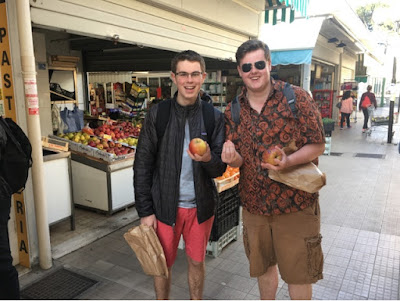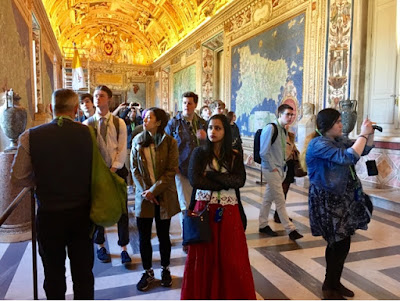The Baths of Diocletian was so large and that was only less than a quarter of it. To think that the bath was built only in 6 years. That must have taken a lot of slaves. It was vast and no wonder it was the largest bath in the empire. The floor was amazing and seeing all the Zodiac tiles was amazing. Poor Scorpio was small and hidden by a column.
 |
| Little Scorpio hidden in the corner |
 |
| Photo by Weston the Baths of Diocletian |
St. Maria Della Vittoria was covered with intricate designs, but the Ecstasy of Saint Teresa was smaller than I thought it was. I'm so glad it was not behind a protective wall, but I wouldn't blame anyone if it was. I'm glad I got to see another piece from the 250 Art History pieces. The church itself was very baroque with all the decorations and the marble facade. It was a small church, but wonderfully decorated.
 |
Photo by Weston The Ecstasy of Santa Teresa Photo by Weston Close up of Teresa |
The Ara Pacis was so vast and breath taking. It was no wonder it got sacked, but it's still sad that it was. I'm so glad it's inside and away from the elements. Augustus built the Ara Pacis after he took over and Rome had a hundred years of war. He then brought about forty years of peace and to honor that he built this giant tomb. What a guy.
 |
| The Ara Pacis in all its majesty |
Also there were skulls motifs! Cow skulls with the garlands! Now this is my kind of tomb. It's so decorated and beautiful. No wonder why Augustus called it an accomplishment! It was well worth forty years of peace.
 |
| Soup's favorite past the skull motifs |
Lunch was refreshing and delicious! The market food was cheap and the park at Borghese was lovely. Enjoying the time to rest and talk with friends was quite nice after a busy morning of visiting Churches.
 |
| A part of the Borghese gardens were everyone had lunch |
The museum at Villa Borghese was overwhelming but so amazing! The mosaics and statues and paintings were all stunning. The hour and a half passed by quickly. That's a theme in Rome so much to do and so little time to do it.
 |
| A gladiator stabbing a leopard |
 |
| Statue of Aeneas with his father and son in the Villa Berghese |
We then had time after Borghese to split into interest groups to see even more places, so the AP Art History students and two others (Abigail and Steven) opted to see more art in churches. We went to San Carlo alle Quattro Fontane and Chiesa il Gesu. Sadly, we couldn't get into the first church, but we did manage to get into il Gesu.
In Il Geso we saw the Triumph in the name of Jesus and I highly recommend going if you can. It was breath taking. Inside they have a mirror so you can see the ceiling. The amazing part about the ceiling is you can't tell what is sculptor and what is painting. I wish the entire group could have seen it.
 |
| Triumph in the name of Jesus in Chiesa il Gesu |
Weston was really amazing today because not only did he have the role of navigator for the entire group to the Spanish Steps, but he navigated the small group to the churches around Rome. This group walked an additional 3 miles across Rome. We won the Rome thing.
Then we went to a fantastic tea shop by the Spanish Steps. I had a lovely Vanilla Green tea and a little muffin like thing. It was amazingly good! And we were able to recover before dinner and if was fabulous.











































